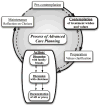Engagement in multiple steps of the advance care planning process: a descriptive study of diverse older adults
- PMID: 18410324
- PMCID: PMC5723440
- DOI: 10.1111/j.1532-5415.2008.01701.x
Engagement in multiple steps of the advance care planning process: a descriptive study of diverse older adults
Abstract
Objectives: To assess engagement in multiple steps of the advance care planning (ACP) process 6 months after exposure to an advance directive. In this study, ACP is conceptualized similarly to the behavior change model.
Design: Descriptive study.
Settings: County general medicine clinic in San Francisco.
Participants: One hundred seventy-three English or Spanish speakers, aged 50 and older (mean 61) given a standard (12th-grade reading level) and an easy-to-read (5th-grade reading level) advance directive.
Measurements: Six months after exposure to two advance directives, self-reported ACP contemplation; discussions with family, friends discussions with clinicians; and documentation were measured. Associations were examined between ACP steps and between subject characteristics ACP engagement.
Results: Most participants (73%) were nonwhite and 31% had less than a high school education. Sixty-one percent contemplated ACP, 56% discussed ACP with family or friends, 22% discussed ACP with clinicians, and 13% documented ACP wishes. Subjects who had discussed ACP with their family or friends were more likely to discuss ACP with their clinicians (36% vs 2%, P<.001) and document ACP wishes (18% vs 4%, P=.009) than those who had not. Latinos and subjects with less than a high school education discussed ACP more often with family or friends (P<.06) and clinicians (P<.03) than other ethnic groups and subjects with more education.
Conclusions: ACP involves distinct steps including contemplation, discussions, and documentation. The ACP paradigm should be broadened to include contemplation and discussions. Promoting discussions with family and friends may be one of the most important targets for ACP interventions, and literacy- and language-appropriate advance directives may help reverse patterns of sociodemographic disparities in ACP.
Figures


References
-
- Emanuel LL, Danis M, Pearlman RA, et al. Advance care planning as a process: structuring the discussions in practice. J Am Geriatr Soc. 1995;43:440–446. - PubMed
-
- Tulsky JA. Beyond advance directives: importance of communication skills at the end of life. Jama. 2005;294:359–365. - PubMed
-
- Lo B, Steinbrook R. Resuscitating advance directives. Arch Intern Med. 2004;164:1501–1506. - PubMed
-
- Prochaska JO, Velicer WF, Rossi JS, et al. Stages of change and decisional balance for 12 problem behaviors. Health Psychol. 1994;13:39–46. - PubMed
-
- Pearlman RA, Cole WG, Patrick DL, et al. Advance care planning: eliciting patient preferences for life-sustaining treatment. Patient Educ Couns. 1995;26:353–361. - PubMed
Publication types
MeSH terms
Grants and funding
LinkOut - more resources
Full Text Sources

